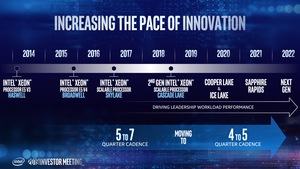
The most important part of the information: The off for all manufactured in 10 nm desktop processors from Intel. Instead, Intel is focusing entirely on 7 nm manufacturing in this segment. However, more than two years will pass before that happens.
Basically, the information in the same score, as well as other messages before. Intel has had to admit that the change from 14 nm to 10 nm was and is problematic. Although Intel is proud to announce its successful production in 10 nm with the mobile Ice Lake processors, we are talking about small, mobile processors that only achieve very low clock rates compared to the models made in 14 nm . In addition, the numbers of manufactured in 10 nm processors compared to the volume of 14-nm manufacturing are extremely low.
Intel does not achieve the desired and required clock speeds for the Ice Lake-based desktop processors, and instead uses Comet Lake-S and Rocket Lake-S to create an alternative 14 nm manufacturing schedule. A 10 nm desktop processor therefore do not give it. So far, there are no signs of early engineering samples based on Ice Lake-S or Tiger Lake-S. If then it is exclusively for processors for notebooks. Only with Meteor Lake will you 2022 bring a first manufactured in 7 nm desktop processor on the market - so the source.
Intel's intended core processors for the desktop
production CPU μArch GPU μArch Launch
Coffee Lake-S 14 nm Skylake Gen9.5 2018
Skylake-X 14 nm Skylake - 2018
Cascade Lake-X 14 nm Skylake - 2019
Comet Lake-S 14 nm Skylake Gen9.5 2019/20
Rocket Lake-S 14 nm Skylake Gen12 2021
Alder Lake 10 nm - - 2022
Meteor Lake 7 nm - - 2022
This information fits as I said quite well in the current picture and the current rumor situation. Intel will release the Comet Lake S processors, which will offer up to 10 cores, but continue to be manufactured in 14 nm, possibly this year. But with Rocket Lake-S is at least one in terms of manufacturing as a hybrid processor to be designated, the CPU cores are manufactured in 14 nm, the graphics unit should be made but at least 10 nm. Whether there will ever be a Rocket Lake for the desktop remains to be seen.

" to the gallery
If the information from our source is correct, all 10 nm desktop processors made by Intel have been completely discontinued. This applies especially to Tiger Lake-S. But there will be mobile processors based on the Tiger Lake design. This was confirmed by Intel at Investors Day in May this year . Features will be a "new CPU Core Architecture" , the new "new Xe Graphics Engine" and "next Gen I / O Technology" . Since Intel also speaks in this context of "Mobility Redefined" , this refers in fact only to the mobile Tiger Lake variants.
7 nm planned on the desktop for 2022
For the desktop, Intel intends to offer the first desktop processors from 7 nm production in 2022, according to inside information. Until then, one leaves the competitor more or less the market when it comes to the interplay of new architectures and modern manufacturing technologies. Comet Lake-S and Rocket Lake-S are to form the bridge in two steps, until the chip giant is back on track.
To slow down the current strengthening of the competitor AMD, Intel should take a lot of money in the hand and put in advertising and marketing. Also on the price you want to exert pressure on AMD. Basically, it should also play no role for the customer and the OEMs, whether a processor in 14, 10 or 7 nm is manufactured. As long as the price and the performance are correct, this should not matter. Being technically at the forefront is just as important for companies, and Intel currently has little to offer.
In addition, Intel seems to set the current strategy to 14 nm, not to drive so bad. Surely you lag behind in the number of cores, how big this advantage is for AMD, it can be argued well. Instead, Intel is focusing on the mobile processor market - Comet Lake-U / Y and Lakefield are visible signals in this direction . Also with the Xeon models Intel sticks to the plans, although these are no less ambiguous, than with the desktop.
Ice Lake Xeons remain on the roadmap
In 10 nm manufactured desktop processors for Intel, according to the latest information does not seem to be useful. They do not achieve the required clock rates and thus offer no significant advantage over the highly optimized and inexpensive to manufacture 14nm processors.
But Intel still has Xeon processors based on Ice Lake on its roadmap. Most recently, these were confirmed in spring:

" to the gallery
Cooper Lake and Ice Lake will be based on one platform with the Xeon processors and use the LGA4189 . Not only are they somewhat compatible with each other, they will also coexist in the market, which should be unique in Intel's product strategy. Cooper Lake is still based on the Skylake μ architecture, but there will be more extensions like AVX-512_BF16 (BFloat16) . Ice Lake, on the other hand, uses the Sunny Cove cores, which provide many of the current AVX-512 extensions, but not those for BFloat16.
Intel processors for servers
production CPU μArch GPU μArch Launch
Cascade Lake 14 nm Skylake - 2019
Cooper Lake 14 nm Skylake - 2020
Ice Lake 10 nm Sunny Cove - 2020
Sapphire Rapids 10 nm Willow Cove - 2021
Granite rapids 7 nm Golden Cove - 2022
Cooper Lake will, as I said, share the platform with Ice Lake. While Cooper Lake will offer up to 56 cores per socket, only 28 cores are planned for Ice Lake. The high-core-count (HCC) and extreme-core-count (XCC) chips are said to have a major impact on 10nm manufacturing issues. One reason for this is a technique called Contact Over Active Gate (COAG). COAG is a new method of gate bonding used by Intel in 10nm fabrication. The technique should continue to be problematic and risky. The failure of the Cannon-Lake processors is largely attributed to problems with the COAG technology.
Low clock rates and the COAG problem actually speak against the appearance of the Ice Lake Xeons and yet Intel sticks to it. The reasons are unknown. The next step is Intel Sapphire Rapids. Here Intel is said to continue its current strategy in 10nm manufacturing, but already set to the 10nm ++ process.
As always with rumors, the information should be treated with some caution.
Source: https://www.hardwareluxx.de/index.p...t-10-nm-plaene-fuer-den-desktop-komplett.html
![[H]ard|Forum](/styles/hardforum/xenforo/logo_dark.png)

